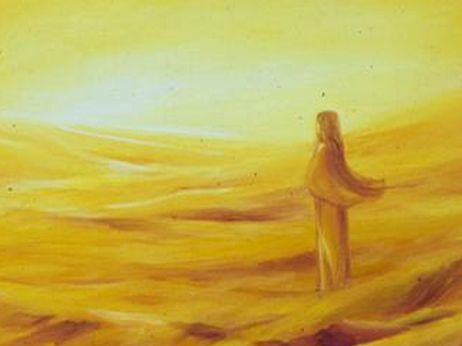I’m sharing below a short excerpt of a book by A.B.Purani I on symbols in poetry. Having been ‘under-the-influence’ of some fairly symbol-rich poetry over the past decade, I was filled with gladness to have found this beautiful passage that actually threw light on what a ‘symbol’ represents.
A few lines of poetry that (to me) evince such symbolism :
“It lit the thoughts that glow through the centuries“ 2
“..An eye awake in the voiceless heights of trance“ 3
“Lulled by Time’s beats eternity sleeps in us“ 4
“A blazing eye of Time watching the motionless day“ 5
– A description of the Sun, in whose sight and to which, the ‘day’ is eternal. To have written this line, the poet would have to had experienced being the Sun – it is not a symbol that can ordinarily leap to an abstracting or even brilliantly imaginative mind.
“I am the storm, which, sunk in me
For a while evades your senses“ 6
“The Adorer and Adored self-lost and one“ 7
On to the passage itself : (emphasis mine)
“All language is symbolic“ 1
In poetry symbols come naturally as very effective means for expressing the poet’s experience, besides being economical. According to C.Day Lewis, the special faculty of the poet is the “power of creating images”. These “images” that a poet creates are a kind of sign-language which forces itself on him under the stress of the creative impulse or in the moments of intensity of his creative faculty. The “image” created by the poet is effective and therefore authentic in proportion as it conveys the experience or the state of consciousness, without diminution or distortion. When the image is authentic it is a symbol, that is to say, it does not merely represent the experience but conveys the experience and is the most effective expression of it in language. Sri Aurobindo calls this “the finding of the inevitable word” and “inspired phrase“.
“Vision is the characteristic power of the poet, as is discriminative thought the essential gift of the philosopher and analytic observation the natural gift of the scientist”.
It is the faculty of vision, the power of seeing the truth of one’s experience or even some supra-intellectual Truth embodied as a symbol that gives the poet his special expressive power. It is true that a poet can create, or rather construct with the help of his imagination, an intellectual symbol which conveys his import to other people by a figure of symbol which represents rather than is the experience. Kalidas can use the “Cloud” as a “messenger” and Shelley convey the poet’s Truth through the “Skylark”.
:
With regard to the function of the symbol in expression Sri Aurobindo says in another letter: ” A symbol expresses not the play of abstract things or ideas put into imaged form but a living Truth or inward vision or experience of things, so inward, so subtle, so little belonging to the domain of intellectual abstraction, and precision that it cannot be brought out except through symbolic images – the more these images have a living truth of their own which corresponds intimately to the living truth they symbolise, the greater becomes the art of the symbolic expression.”
One analogy that occurred to me was that of word-vibrations in Sanskrit, which owing to the experiential quality to its word-sounds, can contain and fully express the experience which they represent. In another sense, I feel a ‘symbol’ of poetry may also have a parallel in the rendition of a Raag in Indian classical music. The authenticity, and experiential quality of one artist’s genuine evocation of a Raag distinguishes itself from the reams of famous artists who have also played the same Raag ‘very well’. There is such a thing as the inward experience and state of the artist, and that can manifest itself in the music to be self-evidently symbolic.
References
I A.B.Purani, “Sri Aurobindo’s Savitri – An Approach and a Study“,pg 10. 1st pub 1952; ISBN :81-7058-683-6
1 Lasceiles Abercrombie
5 In horis Eternum, Sri Aurobindo
6 Herbert Read
2,3,4,7 from the epic Savitri, by Sri Aurobindo



